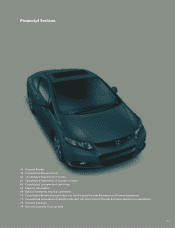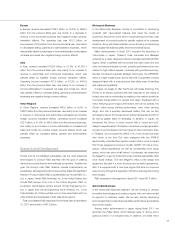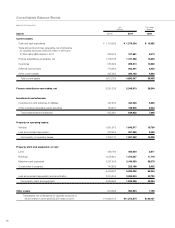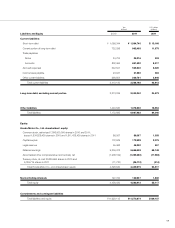Honda 2011 Annual Report Download - page 52
Download and view the complete annual report
Please find page 52 of the 2011 Honda annual report below. You can navigate through the pages in the report by either clicking on the pages listed below, or by using the keyword search tool below to find specific information within the annual report.
As a result, Honda recognized ¥45.7 billion of costs and expenses,
of which ¥17.4 billion is included in cost of sales and ¥28.2 billion is
included in selling, general and administrative expenses in the
accompanying consolidated statement of income for the year ended
March 31, 2011. These costs and expenses mainly consist of
unallocated fixed production overhead of ¥15.0 billion caused by
temporary suspension of production which is included in cost of
sales, and loss on damaged property, plant and equipment of ¥15.6
billion which is included in selling, general and administrative
expenses. Fixed costs of ¥7.7 billion pertaining to certain R&D
activities incurred during the period when such activities were
suspended are not included in research and development, but
selling, general and administrative expenses. Substantially all of
these costs and expenses resulting from the disaster are included in
operating expenses of the automobile business segment. Honda will
recognize the costs of future restoration activities as they are
incurred. The effect of this disaster on Honda’s sales activities for the
year ended March 31, 2011 was immaterial.
By April 11, 2011, Honda had resumed production activities at all
of its production sites; however, production at Honda’s automobile
plants both in and outside of Japan has been temporarily reduced.
As of the date of the filing of Honda’s Form 20-F (as of June 23,
2011), recovery from shortage of certain parts supplies is in sight.
Honda expects its domestic production to have been nearly
normalized by late June and its overseas production will be nearly
normalized in the August/September timeframe except certain types
or models of automobile products which will have continuous
restricted parts supplies.
Concerning the impact on profit on the next year’s consolidated
financial statements, Honda estimates factors which weigh on profit
mainly in the automobile business segment such as decreased net
sales of automobile business attributable to a shortage of inventories,
unallocated fixed production overhead as a result of temporary
reduced production, and the costs of restoration activities can occur.
On the other hand, net sales of automobile business is expected to
recover after normalization of production. Honda believes the impact
of the Earthquake will not be severe on Honda’s consolidated
financial position or results of operations and will not continue over a
long period.
Honda’s R&D subsidiaries located in Tochigi Prefecture set up
satellite offices within the plants and other offices as it would take
some time to restore its buildings and facilities, and resumed R&D
operations on March 28. As a result, Honda has been able to
minimize the impact of the Earthquake on R&D activities. The satellite
offices were dissolved in early June.
Application of Critical Accounting Policies
Critical accounting policies are those which require us to apply the
most difficult, subjective or complex judgments, often requiring us to
make estimates about the effect of matters that are inherently
uncertain and which may change in subsequent periods, or for
which the use of different estimates that could have reasonably been
used in the current period would have had a material impact on the
presentation of our financial condition and results of operations. A
sustained loss of consumer confidence which may be caused by
changes in consumer preferences and rising fuel prices, effects of
the Great East Japan Earthquake or other factors have combined to
increase the uncertainty inherent in such estimates and
assumptions.
The following is not intended to be a comprehensive list of all our
accounting policies.
We have identified the following critical accounting policies with
respect to our financial presentation.
(Product Warranty)
We warrant our products for specific periods of time.
Product warranties vary depending upon the nature of the
product, the geographic location of their sales and other factors.
We recognize costs for general warranties on products we sell
and product recalls. We provide for estimated warranty costs at the
time products are sold to customers or the time new warranty
programs are initiated. Estimated warranty costs are provided based
on historical warranty claim experience with consideration given to
the expected level of future warranty costs, including current sales
trends, the expected number of units to be affected and the
estimated average repair cost per unit for warranty claims. Our
products contain certain parts manufactured by third-party suppliers.
Since suppliers typically warrant these parts, the expected
receivables from warranties of these suppliers are deducted from
our estimates of accrued warranty obligations.
We believe our accrued warranty liability is a “critical accounting
estimate” because changes in the calculation can materially affect
net income attributable to Honda Motor Co., Ltd., and require us to
estimate the frequency and amounts of future claims, which are
inherently uncertain.
Our policy is to continuously monitor warranty cost accruals to
determine the adequacy of the accrual. Therefore, warranty expense
accruals are maintained at an amount we deem adequate to cover
estimated warranty expenses.
Actual claims incurred in the future may differ from the original
estimates, which may result in material revisions to the warranty
expense accruals.
50
























